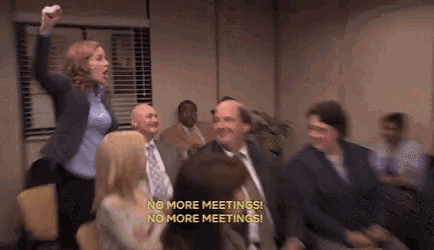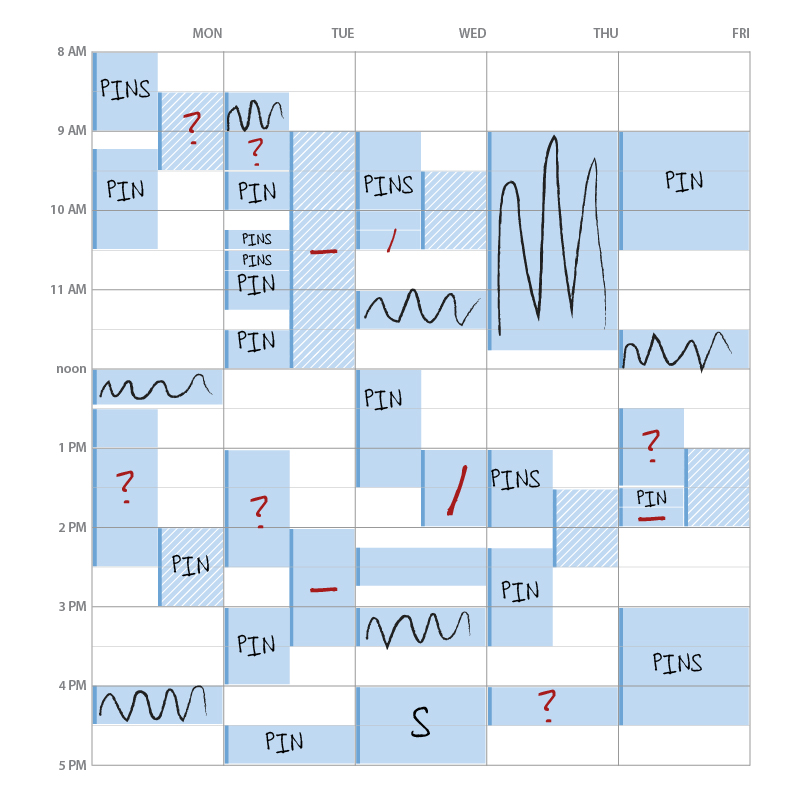In many organizations, calendars are packed with meetings. People go from one Zoom call or conference room to another. Individual work gets puzzled around the edges with whatever time and energy is left. The larger the organization and the more senior the role, the worse it gets.
A few companies have seen the infection and just cut off the limb—”no more meetings here,” they declare, “We can interact via Slack and email.” (As if the inbox is no less of a time sink than the full calendar!) This even made it into an episode of The Office, with Pam starting a “No more meetings!” chant.

Without a doubt, people have too many meetings on their calendars. But is the solution getting rid of meetings altogether? To answer that question, we have to first answer the question of what meetings are good for.
3 Conditions
A meeting is a great tool when the following three conditions are true:
- the participants are bringing different perspectives and information into the meeting
- the interactions between the participants during the meeting will produce new information and insights beyond the sum of their individual information
- the group needs to use that new information and insights to make a decision, align on next steps, and/or give advice
For example, in a good sprint retrospective meeting, the participants are bringing different perspectives and information from their experiences during the sprint. They’re exploring and interpreting that information together to generate insights about how the team works. And they’re using those insights to make a decision about what experiment to try in the next sprint.
That’s worth a meeting. You’re not likely to get that kind of outcome from an email thread or Slack conversation.
But if you don’t need to make a decision together, if the meeting is just about sharing information, that’s often better done asynchronously using email or another medium.
There is an exception, a situation where a meeting might be the right choice, even if the 3 conditions aren’t true. If you want want to increase social connection, either casually as in a team lunch or a social hour, or intentionally, like when you want to communicate about an important change (with respect to vision, strategy, a crisis, etc.) and you want to do that in a human-centric way instead of an informal, one-way communication.
Social connection is important, especially when there are remote co-workers, and it probably warrants some intentionality in creating those opportunities. But beware the “forced team fun” risk here.
Too Many Meetings? Try This…
Take a look at your calendar for the next week or two, whichever is most typical for you. Print it out or screenshot it so you can mark it up. Scribble out any blocks on your calendar that aren’t meetings with other people. If you’re like us, you probably block time on your calendar for individual work. The only thing left will be scheduled meetings with at least one other person.
First, you’re going to annotate each meeting using four possible letters P-I-N-S as follows:
- Perspective: For condition 1, where participants bring different information and perspectives to the meeting, add the letter P.
- Insights: For condition 2, where the meeting could result in additional insight through that combined perspective, write the letter I.
- New: For condition 3, where using that additional insight will result in something new happening after the meeting that couldn’t have happened without it, like a decision, alignment on next actions, or advice and input, write the letter N.
- Social: If the meeting has a goal of increasing social connection, write the letter S.
Next up, we’ll use a different color to highlight changes you might want to take relative to your calendar:
? Add a question mark on any meeting where you weren’t sure how to label it with the PINS annotations. This could mean the meeting organizer hasn’t shared enough detail, or you are uncertain who is attending, the meeting goal, or whether it will be facilitated effectively to achieve the desired outcomes. Any meetings you’ve accepted that have a question mark mean you have some follow up to do with the meeting organizer.
– Put a dash on the meetings where you don’t need to be there in order to achieve the desired outcomes. The meetings will go just fine without you there, so kindly bow out.
/ Finally, put a slash through any meeting that doesn’t need to be a meeting because it’s just information sharing or status reporting. If you know the agenda and you didn’t add a PIN or S to it, it probably shouldn’t be a meeting.

Some meetings, you may want to try to influence towards better facilitation. Where you’re a participant, ask for an agenda and how you can prepare to contribute well. Where you’re the facilitator, take steps to ensure you’re running an effective meeting.
Some meetings, you may want to try to bow out of. Smaller meetings tend to be more effective, so don’t feel bad about asking if the meeting really needs you.
Some meetings probably shouldn’t happen. If they’re your meetings, run an experiment with an alternative. If you’re a participant, consider how you might influence the meeting organizer to try something else.
Take these steps, and you’ll have better meetings and a clearer calendar.
Learn How to Run Better Meetings
We’re teaching facilitation at two upcoming events:
The 6 Goals of a Great Facilitator
Thursday, August 17, 2023
5:00 PM to 6:30 PM MDT (Denver)
This free session will walk through how great facilitators achieve 6 goals in almost any meeting and move from one to the next fluently and mindfully. Join the Humanizing Work Community Meetup and register for this event here.
The Art of Great Facilitation
Aug 22, 2023
1:00PM – 5:00PM MDT (Denver)
Facilitation is a key part of the job for ScrumMasters, Product Owners, leaders, trainers, and coaches. But few people have intentionally developed this skill. During this virtual, hands-on workshop, participants will learn techniques for leading engaging and productive meetings and then practice the essential skills and tools needed to facilitate more confidently and effectively. Register here and use coupon code, GF202308, for $100 off!
Join us, and pass this along to the other meeting organizers you know!
Last updated